

|
Polars Performance Data on the Hobie 16 and Others By Bill Mattson Data provided by Al Bowers At press time it was noted that these charts may not be entirely accurate due to the software I used to produce them. We expect to have them updated in the near future. Thank you for your patience. -Bill Mattson To visualize the performance of a sailboat at various angles to the wind, a "polar" chart provides the best picture. Al Bowers recently sent us 6 polar charts for various sailboats including the Hobie 16. The charts were of varying sizes and types, and some were a bit larger than our little hand scanner. So, I transposed the data into charts of the same size to both provide an easier comparison between the boats and accomodate our meager equipment. |
|
For those not familiar with a polar chart, the sample chart at the right should provide
some help. The numbers down the left side of the chart represent the boat speed. The angles
represent the boat heading relative the the wind. The wind originates from the top of the chart and is 10 knots for all charts. The "X" in the sample chart represents a boat speed of 8 knots while heading 45 degrees from the true wind. | 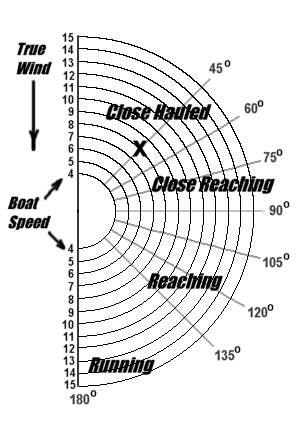
|
Here are the actual polar charts for the 6 boats: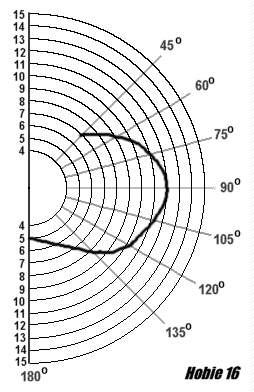 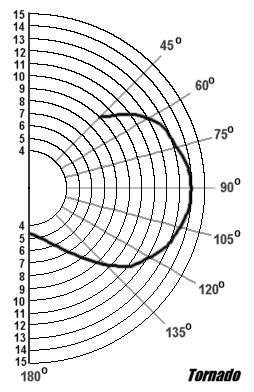 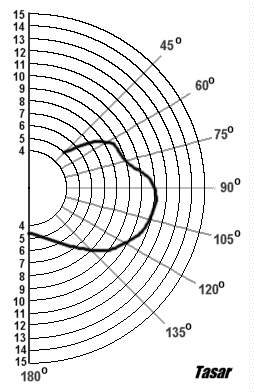 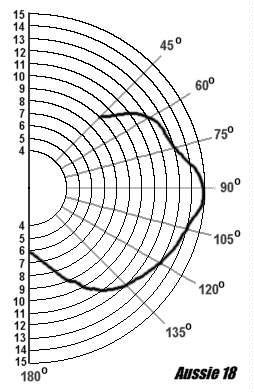 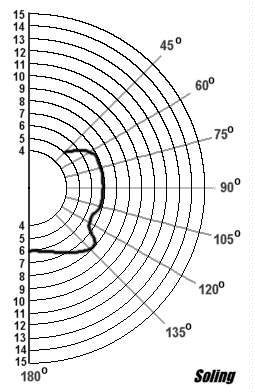 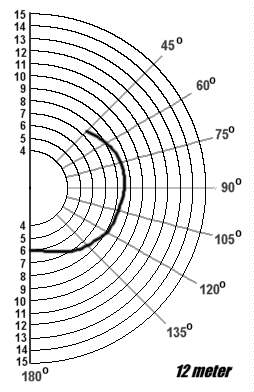 Here's a chart showing the boats in comparison:  Al Bowers comments: "...None of these boats goes downwind fastest at 180 to the true, they all tack downwind...Be aware that these are from different sources, and salt vs fresh water will affect these numbers, just as wave conditions will (most of the time none should be able to get numbers this good). Also, the numbers are all for 10 knots. I had to interpolate the 12 M numbers as I only had 7 and 12 knots wind. The skiff and the Tasar are planing everywhere they are over 7 knots; both show a characteristic "double hump" in their polars which is symptomatic of planing boats. None of the other four boats have a double-hump and all are displacement boats (this does not mean "hull speed" applies though!). Hull speeds (FWIW) are: 5.5, 6.5, 5.0, 6.2, 7.0, and 10.5 knots respectively. Also, this only applies in about 10 knots of wind. In higher and lower wind speeds, these do NOT scale up or down. Especially in lower wind speeds. Anyone who has tried to sail a small cat against a large leadmine in light air will tell you that the cat will get slaughtered everytime. In light air (below 5 knots) the boundary layer across the earth is laminar and there is very little wind down low. At 6 knots or higher wind speed the boundary layer is turbulent and there is more wind down low and that is when cats "come alive" and we slaughter everyone else. Well, maybe not the Aussie 18s, but then for the money those folks spend, we can let them win. Just follow them until they capsize, then be sure to wave and smile cheerfully as you sail by..." Al Bowers bowers@ptw.com Bill Mattson mattson@earthlink.net Sources: H16: Hobie Hotline (cira 1978) Tornado: C A Marchaj, "Aero Hydrodynamics of Sailing" Tasar: F Bethwaite, "Australian Sailing" magazine, 11/77 Skiff: F Bethwaite, "High Performance Sailing" Soling: F Bethwaite, "High Performance Sailing" 12 Meter: C A Marchaj, "Aero Hydrodynamics of Sailing" Back to Features |